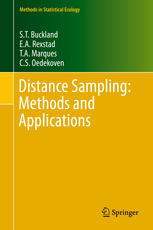

Most ebook files are in PDF format, so you can easily read them using various software such as Foxit Reader or directly on the Google Chrome browser.
Some ebook files are released by publishers in other formats such as .awz, .mobi, .epub, .fb2, etc. You may need to install specific software to read these formats on mobile/PC, such as Calibre.
Please read the tutorial at this link: https://ebookbell.com/faq
We offer FREE conversion to the popular formats you request; however, this may take some time. Therefore, right after payment, please email us, and we will try to provide the service as quickly as possible.
For some exceptional file formats or broken links (if any), please refrain from opening any disputes. Instead, email us first, and we will try to assist within a maximum of 6 hours.
EbookBell Team

5.0
40 reviewsIn this book, the authors cover the basic methods and advances within distance sampling that are most valuable to practitioners and in ecology more broadly. This is the fourth book dedicated to distance sampling. In the decade since the last book published, there have been a number of new developments. The intervening years have also shown which advances are of most use. This self-contained book covers topics from the previous publications, while also including recent developments in method, software and application.
Distance sampling refers to a suite of methods, including line and point transect sampling, in which animal density or abundance is estimated from a sample of distances to detected individuals. The book illustrates these methods through case studies; data sets and computer code are supplied to readers through the book’s accompanying website. Some of the case studies use the software Distance, while others use R code. The book is in three parts. The first part addresses basic methods, the design of surveys, distance sampling experiments, field methods and data issues. The second part develops a range of modelling approaches for distance sampling data. The third part describes variations in the basic method; discusses special issues that arise when sampling different taxa (songbirds, seabirds, cetaceans, primates, ungulates, butterflies, and plants); considers advances to deal with failures of the key assumptions; and provides a check-list for those conducting surveys.